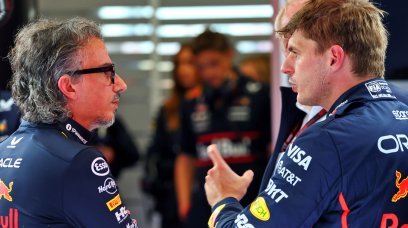The Azerbaijan GP will take place this weekend in Baku, with all teams taking advantage of the April 'mini-break' to focus on the development of their cars: i.e. the upgrade packages that will be likely introduced starting from the Emilia Romagna GP at Imola in mid-May. For Ferrari, the work done in recent weeks was divided into two strands: one linked to the next evolutions of the SF-23, the other concentrated on the present, namely the aerodynamic configurations, suspension set-ups and power unit modes being tested in Maranello in view of the Azeri race. Numerous tests were carried out in the simulator, where, according to sources, no less than eight different configurations were tested. These essentially mixed three suspension set-ups (front and rear), with as many variations in the aerodynamic configuration, in terms of profile of the rear wing, incidence and flap profile of the front wing, and two power unit modes to choose from. The high intensity work paid off with feedback obtained for extracting performance from the SF-23. Indeed, the results have satisfied both the engineers and drivers, when compared directly against the data and mathematical model of the 2022 F1-75 when using the same configurations and power unit modes. The theoretical advantage of the SF-23 compared to the F1-75 on the Baku circuit is around 1.2s, and would be a figure decidedly in line with the average performance increase shown by Red Bull in the first three races between the RB18 and RB19. If such a figure is confirmed when the car hits the track, it would be a 0.5s increase than recorded in the first three races, with the SF-23 only seven-tenths faster on flying laps compared to its predecessor. In the simulator, the parameters Ferrari focused on concerned the stiffness of the suspensions and above all, their dynamic response to load variations, particularly evident on the Baku track and will provide decisive indications for the basic set-up of the car when it hits the track on Friday.
Sprint weekend set-up
The first sprint race of the season will be held in Baku, and there the set-up in FP1 will almost be definitive, so it was crucial for the Scuderia to refine the car settings on the simulator - as cars will enter parc ferme on Friday afternoon instead of 24 hours later. In this sense, the differences in driving preferences of Charles Leclerc and Carlos Sainz were also considered, with the power unit also set to be tested in Baku closer to its maximum potential on the long straights, even more so than in Jeddah. The aerodynamic configuration, in terms of ride height and control of the vertical oscillations - porpoising - seems to have unlocked higher speed and more performance than in 2022 - but most importantly have proved adequate to manage tyre degradation. Most of the development elements that will be adopted on the SF-23 in Baku will simply consist of functional modifications to adapt the car to the track characteristics - these would already have been planned before the 'recovery plan' was adopted and launched. This will come between Imola and Barcelona, with perhaps the first parts in Miami in terms of wings and the floor, which the production department are busy at full speed trying to create.
Low downforce wings
In Azerbaijan, a low-downforce rear wing will be adopted, which is an evolution of the one brought in Jeddah, counterbalanced by the front one with a revised profile and chord of the flaps (above). Recently, an interesting fact was brought to RacingNews365's attention by some aerodynamicists, who were encouraged by the general reduction in the effectiveness of the DRS in Baku, induced by the minimal wings required. Obviously, this is something that impacts all the teams, but the engineers estimate that the level of downforce created in Baku is so much lower that the DRS effect can be reduced by almost 40% compared to a layout like Albert Park - the Australian Grand Prix featuring four zones. This makes it a much more complex task to induce diffuser stall on the straights by exploiting the DRS. In other words, it could be that one of the most obvious strengths of Red Bull could be much less effective in Baku, blunting one of the sharpest weapons of the RB19, and who knows, making it catchable for rivals!?
Most read







